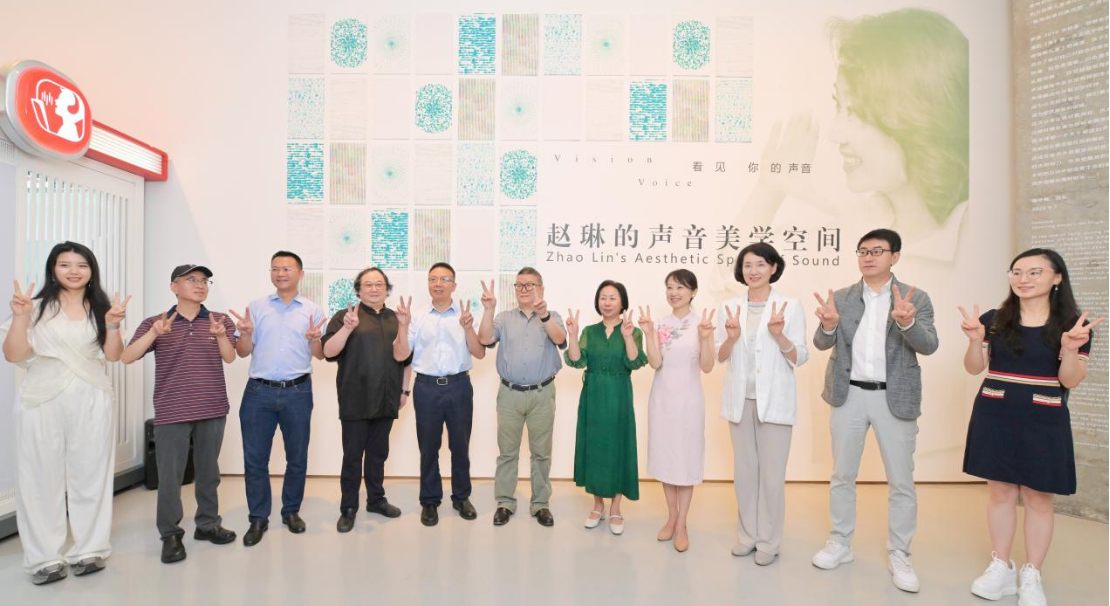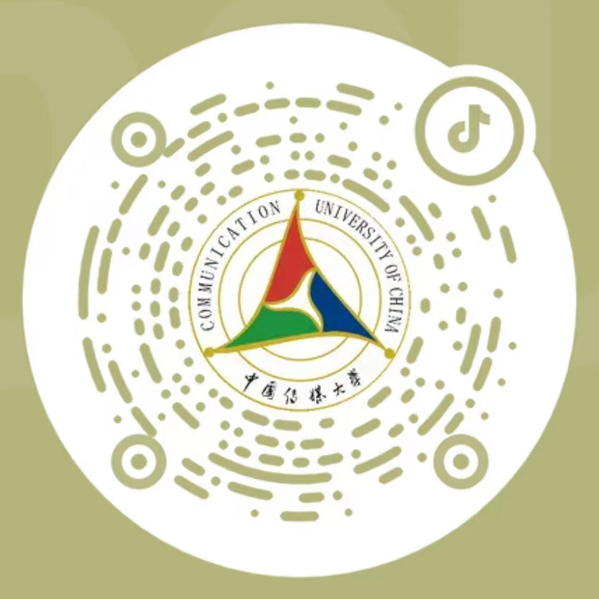By Li Linlu
In late September 2025, as autumn’s golden light settled over Beijing, the “See Your Voice – Zhao Lin’s Aesthetic Space of Sound” public welfare art exhibition opened at the Yixuxi Art Gallery. Running until October 16 and open to the public free of charge, this exhibition marked a creative attempt to integrate sound aesthetics with public welfare and international communication, with the School of International Studies (SIS) of the Communication University of China (CUC) playing a key collaborative role.
Hosted by the Yixuxi Art Gallery and co-organized by the DouDou Special Fund of the Han Meilin Art Foundation, SIS of CUC, Hainan Publishing House, and CUC Press, the exhibition answered the call of the 2025 Central Urban Work Conference to “build a virtuous and civilized city and improve citizens’ cultural literacy.” It also echoed the national strategy to “construct an effective international communication system and tell Chinese stories well.”

“See Your Voice – Zhao Lin’s Aesthetic Space of Sound” opened at the Yixuxi Art Gallery in Beijing.
The exhibition unfolded through three major thematic sections—“Listen to Sound,” “Watch Sound,” and “Sound & Public Welfare”—each exploring the aesthetic and social power of sound.
In the “Listen to Sound Section”, visitors engaged with the “AI Voice Diagnosis + Vocal Practice Capsules,” which analyzed personal vocal features and offered relaxation through rhythm and melody. A dedicated “Interactive Zone for Visually Impaired Children” transformed Braille poems into rotating music box notes, turning verse into tangible melody. These experiences reflected the vision of Professor Zhao Lin, exhibition initiator and SIS scholar, who has long advocated the philosophy of “sound cultivation.” She believes that sound, far from being mere vibration, holds healing power—able to ease anxiety, repair relationships, and soothe the spirit.
In a family, the beauty of sound can soften relationships. Whether it is a calm tone that resolves parent-child tension or a patient voice that comforts in hospitals, sound can mend emotional distance. The “Reading SPA” workshop, featured during the exhibition, guided participants in stress relief through reading and listening, turning professional vocal training into an accessible public practice.

Professor Zhao Lin from the School of International Studies at the Communication University of China explained the “AI Voice Diagnosis + Vocal Training Program.”
The “Watch Sound” section offered an unprecedented sensory experience—sound visualization. Using AI and big data technology, the vocal features of renowned readers were transformed into dynamic visual artworks. Professor Zhao described this transformation succinctly: “Patterns without rhythm lack beauty, and sounds without rhythm are the same—their aesthetic value is proportional.”
This fusion of acoustics and visual art revealed sound’s rhythm as an aesthetic principle that could be both seen and felt. The curator, Professor Wei Dong, explained that the exhibition “extended the beauty of sound to the entire space through multiple media,” while co-curator Chen Yiyi emphasized inclusivity: “This is not an exhibition for experts alone—it is an exhibition where everyone can speak, listen, and participate.”
Beyond art and healing, the exhibition embodied SIS’s commitment to social responsibility. The Sound & Public Welfare section highlighted Professor Zhao’s long-term projects: the “Calling Light Through Recitation” program, which has provided recitation education for visually impaired children for nine consecutive years, and the “Gathering in Beijing” project, which for six years has trained rural teachers in sound aesthetics to enhance expressiveness and empathy in classrooms.
Through these initiatives, sound has become a bridge between emotion and empowerment—a form of education that “heals while it teaches.” As artist Han Meilin and his wife Zhou Jianping noted, “Professor Zhao and her students have painted a colorful world for children through sound—this kind of belief and compassion deserves deep respect.”
One of the exhibition’s most inspiring moments was the formal launch of “International Aesthetic Reading Day,” initiated by SIS of CUC. Supported by the Han Meilin Art Foundation, Taofen Foundation, and multiple publishing houses, this initiative invites people around the world to celebrate the beauty of reading aloud and the power of sound. At the same time, the preview of the world’s first bilingual Heart-Touching Aesthetic Reading Course was announced, aiming to promote cross-cultural communication through sound aesthetics.

The Launch Ceremony of the “September 7 International Aesthetic Reading Day”
Dean Wen Chunying of SIS remarked, “The School of International Studies at the Communication University of China initiated the ‘International Aesthetic Reading Day,’ underscoring that the world’s understanding of China should not be limited to the visual dimension. It is through sound aesthetics that we can convey the tenderness and strength of the Chinese people, allowing the world to perceive China’s aesthetics and philosophy through sound.”
The exhibition also launched a global volunteer initiative—“Voices for China’s Low-Altitude Economy”—calling on multilingual storytellers along the Belt and Road to narrate China’s stories of innovation and sustainable development through sound. Former CCTV English anchor Yang Rui observed, “Effective international communication does not only make the world understand our words; it helps them feel the soul behind our voices.”
Throughout its run, the exhibition hosted six academic and artistic salons. The first, “Sound Aesthetics and the Chinese Story of Low-Altitude Economy,” featured “Father of China’s Low-Altitude Economy” Xu Changdong; the second, “Touch the World with Sound,” brought together representatives from the Han Meilin Art Foundation to discuss art education for visually impaired children. Later sessions explored bilingual poetry recitation, intergenerational reading, and “Sound and Light: Voices of Hope,” featuring figures such as Dr. Tao Yong and broadcaster Dong Lina. Each dialogue built bridges among art, communication, and empathy—demonstrating SIS’s role in merging scholarship with social engagement.
Media coverage was extensive: CCTV.com, People’s Daily Life Weekly, China.com, Hong Kong Ta Kung Pao, Beijing Daily, and China Education Television all reported on the exhibition’s innovative approach, praising its blend of aesthetic exploration and civic mission.

Wen Chunying, Dean of the School of International Studies at the Communication University of China, delivered a speech.
By transforming sound into a medium of empathy, beauty, and understanding, the exhibition shows that when sound is infused with aesthetics, it becomes a lasting force that touches hearts, bridges cultures, and narrates the Chinese story to the world. In Dean Wen’s words, “In a visually dominated era, we must rediscover the aesthetic value of sound as a vital medium of cultural transmission—allowing the world to hear the warmth of China through every voice.”
Editor: Fang Yiran
Managing Editor: Shao Jianyu
Managing Editor: Yu Ran,Yang Zhongtian














